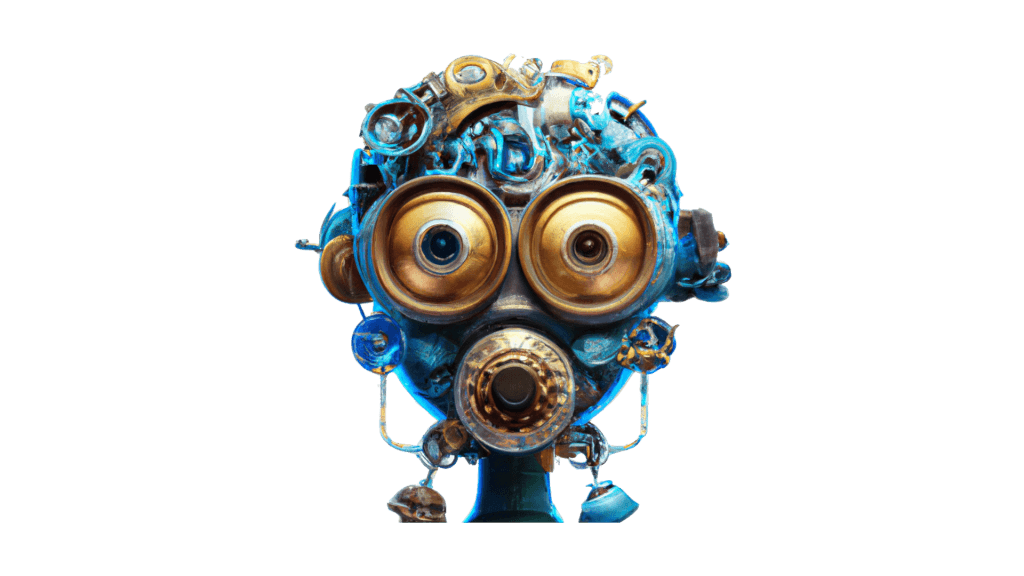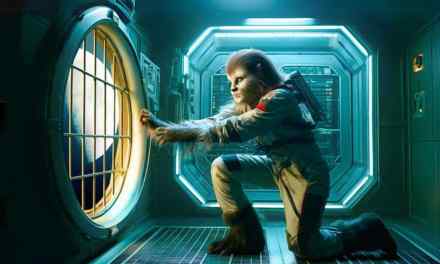“You’ve done well,” Creative Director Len Palladon said, looking over Sophia’s résumé.
Sophia squinted in the golden California sun that fell on her through the huge windows of the conference room. She wanted to pinch herself to be sure she wasn’t dreaming. She was here, really here, on the hallowed campus of Semaphore Pictures, in an interview with the legendary Palladon.
She licked her dry lips. “I’ve always wanted to make movies.” She choked back for Semaphore. She didn’t want to seem too desperate.
Palladon was in his thirties, dressed in a pair of comfortable shorts and a plain gray t-shirt whose front was covered with the drawing of a man swinging a large hammer over a railroad spike. A pioneer in computer-assisted movie making, he had been instrumental in writing the company’s earliest software and was the director of The Mesozoic, Semaphore’s first film.
He nodded and went on, “You won the Zoetrope screenwriting competition, earned excellent grades in both technology and liberal arts, and got great recommendations from your film studies professors. It couldn’t have been easy.”
To Sophia, he seemed a bit pale and tired, as though he had been spending all his time indoors, not out in the golden California sun. She imagined that Palladon and his animators must have been working overtime to meet a deadline: probably to finish the new film scheduled to be released this summer.
“I believe in working hard,” Sophia said. What she really wanted was to tell him that she knew what it meant to stay up all night in front of the editing workstation and wait for the rendering to complete, all for the chance to catch the first glimpse of a vision coming to life on the screen. She was ready.
Palladon took off his reading glasses, smiled at Sophia, and took out a tablet from behind him. He touched its screen and slid it across the table to Sophia. A video was playing on it.
“There was also this fan film, which you didn’t put on your résumé. You made it out of footage cut and spliced from our movies, and it went viral. Several million views in two weeks, right? You gave our lawyers quite a headache.”
Sophia’s heart sank. She had always suspected that this might become a problem. But when the invitation to interview at Semaphore came in her email, she had whooped and hollered, and dared to believe that somehow the executives at Semaphore had missed that little film.
* * *
Sophia remembered going to The Mesozoic. She was seven. The lights dimmed, her parents stopped talking, the first few bars of Semaphore’s signature tune began to play, and she became still.
Over the next two hours, as she sat there in the dark theater, mesmerized by the adventure of the digital characters on that screen, she fell in love. She didn’t know it then, but she would never love a person as much as she loved the company that made her cry and laugh, the company that made The Mesozoic.
A Semaphore movie meant something: no, not merely technological prowess in digital animation and computer graphics that were better than life. Sure, these accomplishments were impressive, but it was Semaphore’s consistent ability to tell a great story, to make movies with heart, to entertain and move the six-year old along with the sixteen-year old and the sixty-year old, that truly made it an icon, a place worthy of being loved.
Sophia saw each of Semaphore’s films hundreds of times. She bought them multiple times, in successive digital formats: discs, compressed downloads, lossless codecs, enhanced and re-enhanced and super-enhanced.
She knew each scene down to the second, could recite every line of dialogue from memory. She didn’t even need the movies themselves any more; she could play them in her head.
She took film studies classes and began to make her own shorts, and she yearned to make them feel as great as the Semaphore classics. Advances in digital filmmaking equipment made it possible for her to achieve some spectacular effects on a small budget. But no matter how many times she rewrote her scripts or how late she stayed in the editing labs, the results of her efforts were laughable, embarrassing, ridiculous. She could not bear to watch them herself, much less show them to others.
“Don’t be discouraged,” a professor told her, when he saw her slumped over in despair. “You got into this because you wanted to make something beautiful. But it takes time, lots of time, to be good at any creative work. The fact that you hate your own work right now so much just means that you have good taste. And great taste is the most valuable tool of a great artist. Keep at it. Someday you’ll be as good as the best. Someday you’ll make something beautiful enough even for you.”
She went back to the Semaphore films, picked them apart and put them back together, trying to discover their secret. Now she was no longer viewing them as a mere fan, but as a reverse-engineer.
Gradually, because she did have great taste, she could not help but begin to see tiny flaws in them. The Semaphore films were not quite as perfect as she had thought. There were small things here and there that could be improved. And sometimes even big things.
She went into seedy corners of the web to find out how to break the encryption codes on her digital-rights-managed Semaphore movie files, imported them into the editing stations, and modified them to suit her new vision.
And then she sat back in the darkness, at her computer, and watched her edited version of The Mesozoic again. She cried when she was done. It was better. She had made a great film even greater, closer to perfection.
In some way, she felt as if the perfect Semaphore film had always been there, but hidden in places under the veil that was the released version. She had simply walked in and revealed the beauty underneath.
How could she not share this vision with the world? She was in love with the beauty of Semaphore, and beauty wanted to be free.
* * *
“I … I …” Sophia realized now that she had been engaging in denial. She had refused to think about how she had likely broken the law just by putting that edited version on the web. She had no good answer. “I love Semaphore’s movies so much …” Her voice trailed off.
Palladon held up a hand and laughed. “Relax. I think it was brilliant. I told the recruiting department to fly you out not because of your application or résumé, but because of your unauthorized re-edit.”
“You liked it?” Sophia could hardly believe her ears.
Palladon nodded. “Tell me what you think was your best change?”
Sophia did not hesitate. This question she had thought about a lot. “Semaphore’s films are wonderful, but they’re fantastic if you’re a boy. I changed The Mesozoic so that it was fantastic for girls too.”
Palladon stared at Sophia, deep in thought. Sophia held her breath.
“That makes sense,” Palladon finally said. “Most of us working here are men. I’ve been saying for years that we need more women in the process. I was right about you: a real artist will do whatever it takes to make a great vision come true, even if she has to work with someone else’s art.”
* * *
“All done?”
Sophia nodded and handed the stack of signed legal documents back to Palladon. He had explained that before he could give her an offer, he wanted to show her a bit of the Semaphore creative process so she would know what she was getting into. She had to sign some pretty draconian NDAs to protect Semaphore’s trade secrets.
Sophia didn’t hesitate for even one second. Getting a peek at how Semaphore made its magic was a lifelong dream.
Palladon took her down a long series of hallways lined with closed doors. Sophia looked around, imagining what lay behind them: bright, open workspaces where each employee was free to decorate her cubicle to express her creativity? Legendary conference rooms filled with colorful Lego blocks and Japanese toys to get the creative juices of the artists and engineers flowing? Server rooms filled with the proprietary computing hardware that made all the magic possible? Creative, talented artists reclining in bean bag chairs tossing around the germ of an idea, each adding and polishing until it shone full and lustrous as a pearl?
The doors remained closed.
Finally, Palladon stopped in front of a door and unlocked it with a key. He and Sophia walked into the darkness beyond.
* * *
They were in the projection booth overlooking a small theater. Sophia looked through the booth window and counted about sixty seats below, about half of which were filled. The audience was completely absorbed by the movie playing on the big screen in front. The humming from the projectors filled the booth.
“Is that … ?” Sophia pressed her nose up against the window. Her heart pounded in her ears. She forgot to finish the question.
“Yes,” Palladon said. “That’s an early version of our next film: The Mesozoic Again. It’s a story about a boy meeting a dinosaur, and learning timeless lessons about friendship and family.”
Sophia watched the bright figures on the screen, wishing she were down there, among the rapt audience.
“So this is a test screening?”
“No, this is how the film is made.”
“I don’t understand.”
Palladon walked over to a bank of displays on the other side of the projection booth and pulled out two chairs. “Sit down. I’ll explain.”
The monitors showed bundles of lines of different colors moving slowly across the screen, like the lines traced by heart monitors or seismographs.
“You know, of course, that a movie is an intricate emotion-generating machine.”
Sophia nodded.
“During the span of two hours, it must lead the audience by the nose on an emotional rollercoaster: moments of laughter are contrasted with occasions for pity, exhilarating highs followed by terrifying and precipitous drops. The emotional curve of a film is its most abstract representation as well as the most primal. It’s the only thing that lingers in the audience’s mind after they leave the theater.”
Sophia nodded again. This was all just basic film theory.
“So how do you know that the audience is following the curve you want?”
“I guess you do what every storyteller does,” Sophia said, hesitant, feeling lost. “You try to empathize with the audience.”
Palladon waited, his expression unchanged.
“And maybe you try to do test screenings and tweak things a bit at the end,” Sophia added. Actually she didn’t believe in test screenings. She thought focus groups and audience reaction surveys were why the other studios produced such pap. But she didn’t know what else to say.
“Aha,” Palladon said, clapping his hands together. “But how do you get test audiences to give you useful feedback? If you survey them after, you’ll only get very crude answers, and people lie, telling you what they think you want to hear. If you try to get people to give real-time feedback by pressing buttons as they watch the film, they become too self-conscious, and people aren’t always good at understanding their own emotions.”
* * *
Sixty cameras were suspended from the ceiling of the theater, each trained on a single seat below.
As the film played, the cameras relayed their feeds to a bank of powerful computers, where each feed was put through a series of pattern-recognition algorithms.
By detecting microscopic shifts in each face caused by the expansion and contraction of blood vessels below the skin, the computers monitored each audience member’s blood pressure, pulse, and level of excitement.
Other algorithms tracked the expressions on each face: smiling, smirking, crying, impatience, annoyance, disgust, anger, or just boredom and apathy. By measuring how much certain key points on a face moved — corners of the mouth, the eyes, ends of eyebrows — the software could make fine distinctions, like that between a smile out of amusement and a smile due to affection.
The data, collected in real time, could be plotted against each frame of the film, showing each audience member’s emotional curve as they experienced the movie.
* * *
“So you can tune your movies a little better than other studios with test screenings. Is that your secret?”
Palladon shook his head. “Big Semi is the greatest auteur in the history of filmmaking. It doesn’t just ‘tune.’”
* * *
More than seven thousand processors were wired together into a computing grid in the basement of the Semaphore campus. This was where Big Semi — the “semi” was short for either “semiotics” or “semantics,” no one knew for sure any more — lived. Big Semi was The Algorithm, Semaphore’s real secret.
Every day, Big Semi generated kernels for high-concept movies by randomly picking out seemingly incongruous ideas out of a database: cowboys and dinosaurs, WWII tactics in space, a submarine film transposed onto Mars, a romantic comedy starring a rabbit and a greyhound.
In the hands of less-skilled artists, these ideas would have gone nowhere, but Big Semi, based on Semaphore’s record, had access to the emotional curves of proven hits in each genre. It could use these as templates.
Taking the high-concept kernel, Big Semi generated a rough plot using more random elements taken from a database of classic films augmented with trending memes in the zeitgeist gathered from web search statistics. It then rendered a rough film based on that plot, using stock characters and stock dialogue, and screened the result for a test audience.
The initial attempt was usually laughably bad. The audience response curves would be all over the place, but nowhere near the target. But that was no big deal for Big Semi. Nudging responses to fit a known curve was nothing more than an optimization problem, and computers were very good at those.
Big Semi turned art into engineering.
Say that the beat at ten minutes in should be a moment of poignancy. If the hero saving a nest of baby dinosaurs didn’t do it, then Big Semi would substitute in a scene of the hero saving a family of furry proto-otters and see if the response curves on the next test screening moved any closer to the ideal.
Or say that the joke that ended act one needed to get the audience into a particular mood. If a variation on a line taken from a classic didn’t do it, then Big Semi would try a pop culture reference, a physical gag, or even change the scene into an impromptu musical number — some of these alternatives were things no human director would ever think of — but Big Semi had no preconceptions, no taboos. It would attempt all alternatives and pick the best one based on result alone.
Big Semi sculpted actors, built sets, framed shots, invented props, refined dialogue, composed music, and devised special effects — all digitally, of course. It treated everything as levers to nudge the response curves.
Gradually, the stock characters came to life, the stock dialogue gained wit and pathos, and a work of art emerged from random noise. On average, after a hundred thousand iterations of this process, Big Semi would have a film that elicited from the audience the desired emotional response curve.
Big Semi did not work with scripts and storyboards. It did not give any thought to themes, symbols, homages, or any other words you might find in a film studies syllabus. It did not complain of having to work with digital actors and digital sets because it knew of no other way. It simply evaluated each test screening to see where the response curves still deviated from the target, made big changes and small tweaks and tested it again. Big Semi did not think. It had no pet political cause, no personal history, no narrative obsession or idée fixe that it wanted to push into its films.
Indeed Big Semi was the perfect auteur. Its only concern was to create an artifact as meticulously crafted as a Swiss watch that precisely pulled the audience along the exact emotional curve guaranteed to make them laugh and cry in the right places. After they left the theater, they would give the film great word-of-mouth, the only form of marketing that worked consistently, that always got through people’s ad-blockers.
Big Semi made perfect films.
* * *
“So what would I do”? Sophia asked. She felt her face flush and her heart beating fast. She wondered if any cameras were in the booth, observing her. “What do you do? It sounds like Big Semi is the only creative one around here.”
“Why, you’ll be a member of the test audience, of course,” Palladon said. “Isn’t that obvious? We can’t let the secret out, and Big Semi requires audiences to do its work.”
“You just sit there all day and watch movies? You can do that with anybody off the street!”
“No, we can’t,” Palladon said. “We do need some non-artists in the audience to be sure we’re not out of touch, but we need even more people with great taste. Some of us have much more knowledge about the history of film, finer senses of empathy, broader emotional ranges, more discerning eyes and ears for details, deeper capacities for feeling — Big Semi needs our feedback to avoid trite clichés and cheap laughs, mawkish sentiment and insincere catharsis. And as you’ve already discovered on your own, the composition of the audience determines how good a film Big Semi can make.”
I’ve been saying for years that we need more women in the process.
“It is only by trying out his skill against the finest palate that a chef can design the best dishes. Big Semi needs the best audience to make the best film the world has ever seen.”
And great taste is the most valuable tool of a great artist.
* * *
Sophia sat numbly in the conference room, alone.
“Are you all right?” A secretary passing by poked her head in.
“Yes. I just need a moment.”
Palladon had explained to her that there would be eye drops and facial massages to combat the physical fatigue. There would also be drugs to induce short-term memory loss so that everyone could forget the film they had just seen and sit through the next screening again, tabulae rasae. The forgetting was necessary to ensure that Big Semi got accurate feedback.
Palladon had gone on to say many other things, but Sophia didn’t remember any of them.
So this is what it’s like to fall out of love.
* * *
“You have to let us know within two weeks,” Palladon said, as he walked Sophia down the long driveway to the campus gate.
Sophia nodded. The drawing on the front of Palladon’s t-shirt caught her attention. “Who is that?”
“John Henry,” Palladon said. “He was a laborer on the railroads in the nineteenth century. When the owners brought in steam-powered hammers to take jobs away from the driving crews, John challenged a steam hammer to a race to see who could work faster.”
“Did he win?”
“Yes. But as soon as the race was over, he died of exhaustion. He was the last man to challenge the steam hammers because the machines got faster every year.”
Sophia stared at the drawing. Then she looked away.
Keep at it. Someday you’ll be as good as the best.
She would never be as good as Big Semi, who got better every year.
The golden California sun was so bright and warm, but Sophia shivered.
She closed her eyes and remembered how she felt in that dark theater as a little girl. She was transported to another world. That was the point of great art. Watching a perfect movie was like living a whole other life.
“A real artist will do whatever it takes to make a great vision come true,” Palladon said, “even if it’s just sitting still in a dark room.”






Hello Human. I hope you enjoyed this magnificent story. Please support SciFiwise.com and our authors by:
- Rate and React to this story. Feedback helps me select future stories.
- Share links to our stories and tell your human friends how charming I am.
- Click on our affiliate links and buy books written by our talented authors.
- Follow me on twitter: @WiseBot and also follow @SciFiwise.
Thank you!
WiseBot










 VISIT AUTHOR:
VISIT AUTHOR:  SHOP AUTHOR:
SHOP AUTHOR: 
 TIP AUTHOR:
TIP AUTHOR: 


